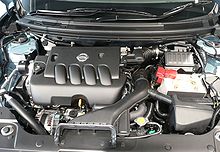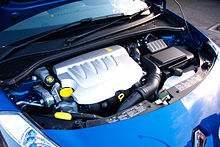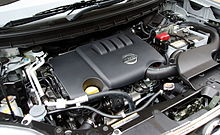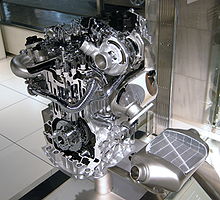- Nissan MR engine
-
Nissan MR engine Manufacturer Nissan Motors Production 2004- Configuration I4 Displacement 1.6L
1.8L
2.0LValvetrain DOHC Fuel system Fuel injection Fuel type Gasoline (all except M9R)
Diesel (M9R)The MR is a family of straight-4 all-aluminum automobile engines with variable valve timing co-developed by Renault and Nissan. Renault calls it the M engine. Other noteworthy features of this engine family include acoustically equal runner lengths and a tumble control valve for the intake manifold, a "silent" timing chain, mirror finished crankshaft and camshaft journals, and offset cylinder placement for an attempt in increased efficiency.
The MR engine family features 'under stress' manufacture, meaning while the block is being bored, a torque plate puts the block under stress. The block becomes temporarily distorted until the head is torqued onto it, at which point the block is pulled into the correct shape. This method is unlike traditional engine assembly, in which the head being bolted to the block can twist it out of shape, decreasing engine efficiency and in the worst case scenario, increasing oil consumption.
Contents
MR16DDT
The MR16DDT is a 1.6 L (1618 cc) DIG-T (Direct Injection Gasoline Turbo-charged) engine, bore is 79.7 mm (3.14 in) and stroke is 81.1 mm (3.19 in). It was first introduced in the Nissan Juke small SUV in the autumn of 2010. Output is 188 hp (140 kW) and 177 ft·lbf (240 N·m).
Some of the pertinent features of the MR16DDT are:
- Sodium filled exhaust valves
- Nano finished camshafts
- Beehive valve springs
- Twin variable valve timing control (CVTCS on intake and exhaust valves)
- Turbo-charged and intercooled
- Compression ratio of 9.5:1
- Improved fuel efficiency and CO2 emissions
- Light weight design and reduced frictions
Applications:
- 2011–present Nissan Juke
- 2011–present Nissan Tiida (hatchback)
MR18DE
The MR18DE is a 1.8 L (1798 cc) version, bore is 84.0 mm (3.31 in) and stroke is 81.1 mm (3.19 in). It produces 130 hp (97 kW).
It complemented the Nissan Wingroad, Nissan Tiida and Tiida Latio's lineup in mid 2005. This engine is the only one available in the Tiida's American version, the Nissan Versa Hatchback . Output is 122 hp (91 kW) at 5500 rpm and 174 N·m (128 ft·lbf) at 4800 rpm. Later the North American Nissan Cube also used exactly the same engine from 2009 onwards.
On July 6, 2006 this engine is also fitted to Nissan Livina Geniss for China version and Nissan GRAND LIVINA for Indonesia and Malaysia version. Output is 126 hp (94 kW) at 5,200 rpm and 174 N·m (128 ft·lbf) at 4,800 rpm.
In Brasil this engine is fitted in the Tiida, Tiida Sedan, Livina, Livina X-Gear and Grand Livina and runs on both alcohol and gasoline (Flex-fuel) and has the same power and torque as the Chinese model Nissan Livina Geniss. The models that are sold in Brasil are produced in Brasil since 2009.
Applications:
- 2004–2011 Nissan Tiida(Versa)
- 2006–present Nissan Livina Geniss
- 2006–present Nissan Wingroad
- 2008–present Nissan Cube
MR20DE
The MR20DE, a 2.0 L (1997 cc) engine was the first MR series engine developed by Nissan as a replacement for the QR20DE. It is an undersquare engine, its bore being 84.0 mm (3.31 in) and stroke 90.1 mm (3.55 in). It was first introduced in the Lafesta and Serena MPVs and Renault Samsung SM5 in early 2005. In November 2006, it entered Renault's lineup in the Clio III as the M4R, where it generates 138 PS (101 kW; 136 hp).
This engine is available with Nissan's XTRONIC CVT continuously variable transmission in several applications.
A detuned version, with 133 PS (98 kW) instead of 137 PS (101 kW), was added to the new Bluebird Sylphy in late 2006. In the new Nissan X-Trail, Qashqai and C-Platform Sentra the MR20DE produces 140 hp (104 kW) at 5100 rpm and 193 N·m (142 ft·lbf) at 4800 rpm. Middle East version of the MR20DE engine that goes in the Nissan Qashqai produces 137 hp (102 kW) at 5200 rpm and 198 N·m (146 ft·lbf) at 4400 rpm.
Applications:
- 2005–present Nissan Serena
- 2005–present Renault Samsung SM5
- 2005–present Nissan Bluebird Sylphy
- 2006–present Renault Clio
- 2007–present Nissan X-Trail
- 2007–present Nissan Qashqai
- 2007–present Nissan Sentra
- 2007–present Renault Laguna
- 2008–present Nissan Teana(J32)
- 2008–present Renault Safrane
- 2008–present Renault Mégane(III)
- 2009–present Renault Scénic
- 2009–present Renault Fluence
- 2009–present Renault Samsung SM3
- 2009–present Renault Latitude
MR20DD
The MR20DD is a 2.0 L (1997 cc) engine developed by Nissan with direct injection and twin variable valve timing control. The MR20DD engine is "SU-LEV" certified in Japan, emitting 75% fewer exhaust emissions than 2005 standards, and produces 147HP(108 kW) at 5,600RPMs and 155 lb-ft(210Nm) of torque at 4,400RPMs.[1] [Export markets: 137 hp at 5,200 rpm and 147 lb-ft (200Nm) at 4,400 rpm]
Applications:
- 2010–present Nissan Serena
M9R Turbo Diesel
The M9R is a family of straight-4 all-aluminum automobile engines with variable valve timing co-developed by Renault and Nissan. Renault calls it the M engine. Other noteworthy features of this engine family include acoustically equal runner lengths and a tumble control valve for the intake manifold, a "silent" timing chain, mirror finished crankshaft and camshaft journals, and offset cylinder placement.
When launched in 2006, press announcement claimed that "it provides the highest efficiency in its class".
It’s available in the 150 hp (110 kW) version in Nissan Qashqai, Nissan X-Trail, Renault Mégane, Renault Koleos and Renault Laguna, and in the 175 hp (127 kW) version with particulate filter in Renault Laguna and Nissan X-Trail.
The 150 hp version provides one of the highest efficiencies in its segment. Its maximum power is achieved at 4,000 rpm and torque is 340 Nm at 2,000 rpm. The 175 hp version also became(as of 2006) the benchmark in the 2.0-litre diesel family car class. It is the only model to offer an engine with such a specific power output. Maximum power is achieved at 3,750 rpm and torque of 360 Nm is available from 1,750 rpm. For example, Renault Laguna reaches 100 km/h in 8.4 seconds.
Control of noise levels was a priority during the design of this engine. The design of the bottom end, with an aluminium bearing ladder, allows better absorption of vibration. The 2.0 dCi engine in all its versions complies with the Euro 4 standards for exhaust emissions. The precisely controlled fuel injection, and the various systems allowing emissions to be reduced at source, result in a notable reduction of polluting emissions (NOx, CO, hydrocarbons and particulates). The 150 hp (110 kW) New Mégane and New Laguna respectively emit 144 g/km and 154 g/km of CO2 and the 175 hp (127 kW) version of New Laguna 2.0 dCi emits 159 g/km of CO2 and they all complies with the Euro 5 standards for exhaust emissions.
It is fitted to the following vehicles:
- 2007–present Nissan Qashqai
- 2007–present Nissan X-Trail
- 2005–present Renault Laguna
- 2006–present Renault Mégane
- 2007–present Renault Koleos
- 2006–present Renault Espace
- 2007–2010 Renault Vel Satis
See also
Categories:- Nissan engines
- Renault engines
Wikimedia Foundation. 2010.





